Principle of operation of the turbine on the diesel engine
Turbochargedv must be the appearance of the notorious German latitude and practicality in everything. More Rudolf Diesel and Gottlip Daimler, at the end of the XIX century, did not give peace of such a question. How so: exhaust gases are just so thrown into the pipe, and the energy they possess does not bring any benefit? Easout ... In the age of twenty-first, the engines equipped with a turbine have long ceased to be exotic and used everywhere, on the most different technique. Why the turbines were distributed primarily on diesel engines and what the principle of operation of these beneficial aggregates, we will look forward to in a strictly popularly popular, but visual and understandable to each form.
So, the idea of \u200b\u200b"put into business" the energy of exhaust exhaust gases appeared soon after the invention and successful experiments of the use of internal combustion engines. German engineers and pioneers of car and tractor buildings, led by Diesel and Daimler, conducted the first experiments to increase engine power and reduce fuel consumption using compressed air discharge from exhaust.
Gotdib Daimler produced such cars, and has already thought about the introduction of the turbocharger system
But the first one who built the first effectively working turbocharger, they became not, and the other engineer is Alfred Bughs. In 1911, he received a patent for his invention. The first turbines were as follows that it was possible to use them and appropriate only on large engines (for example, ship).
Further, the turbocharger began to be used in the aviation industry. Since the 30s of the twentieth century, in the United States, military aircraft (both fighters and bombers) were regularly launched in the United States (both fighters and bombers), gasoline engines were equipped with turbocharger. And the first cargo car with a turbocharged diesel engine was made in 1938.
In the 60s, General Motors Corporation has released the first passenger "Chevrolet" and "Oldsmobili" with gasoline carburetor engines equipped with turbocharging. The reliability of those turbines was small, and they quickly disappeared from the market.

OldSmobile JetFire 1962 - the first serial car with turbocharged
Fashion on turbocharged motors returned at the turn of the 70s / 80s, when turbocharging began to be widely used in creating sports and racing cars. The "Turbo" prefix became extremely popular and turned into a peculiar label. In the Hollywood films of those years, superheroes have been prescribed on the panels of their supercars "Magic" "Turbo" buttons, and the car carried away into the distance. In the real reality, the turbochargers of those years tangible "dried", issuing a significant reaction delay. And, by the way, not only did not contribute to saving fuel, but on the contrary, increased its consumption.
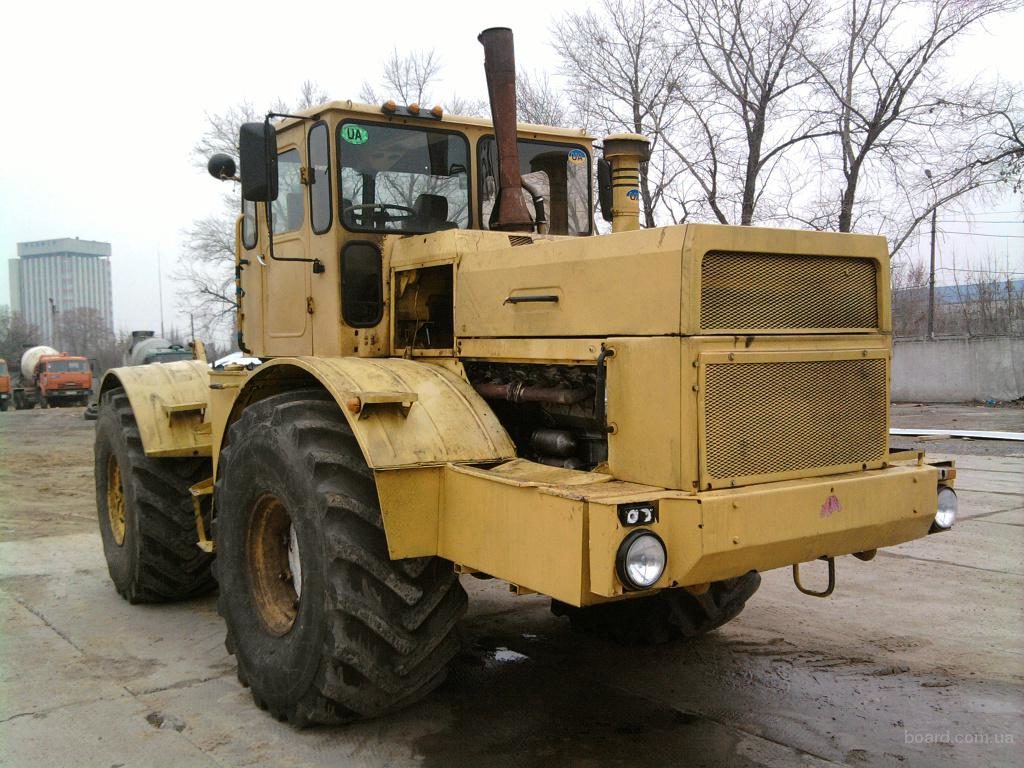
Duplex of Soviet fields - with turbocharged
The first truly successful attempts to introduce turbocharging into the production of car engine production engines were carried out in the early 80s "Saab" and "Mercedes". These advanced experiences did not slow down to take advantage of other global engineering companies.
In the Soviet Union, the development and implementation of turbocharged engines in the "series" was associated, primarily with the development of heavy industrial and agricultural tractors -, "Kirovets"; Supersumes "BelAZ", etc. Powerful technology.
Why, as a result, the turbine was distributed exactly on diesel, and not gasoline engines? Because diesel engines have a much greater degree of air compression, and their exhaust gases are lower temperatures. Accordingly, the requirements for the heat-resistant turbine are much less, and its value and efficiency of use are much more.
The turbocharging system consists of two parts: from the turbine and turbocharger. The turbine is used to convert waste gases, and the compressor is directly for the supply of repeatedly compressed atmospheric air into cylinder workers. The main parts of the system are two blade wheels, turbine and compressor (so-called "impellers"). The turbocharger is a technological pump for air, resulting in the rotation of the turbine rotor. Its only its task is to discharge compressed air into cylinders under pressure.
The larger the air will go into the combustion chamber, the more diesel diesel can be burned for a specific unit of time. The result is a significant increase in the power of the motor, without the need to build up the volume of its cylinders.
Composite parts of the turbocharging device:
- compressor housing;
- compressor wheel;
- rotor shaft, or axis;
- turbine case;
- turbine wheel;
- bearing housing.
The basis of the turbocharged system is a rotor, fixed on a special axis and imprisoned in a special heat-resistant building. The continuous contact of all components of the turbine with extremely hot gases determines the need to create both the rotor and the turbine housing from special heat-resistant metals.
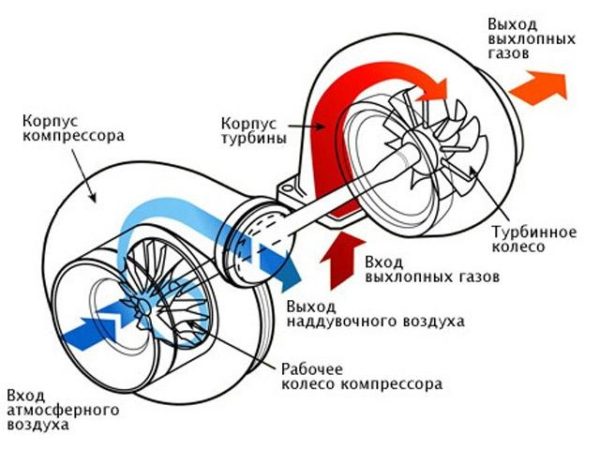
The impeller and the turbine axis rotate with a very high frequency and in opposite directions. It provides a dense clamp of one element to another. The flow of exhaust gases penetrates first to the exhaust manifold, from where it comes to a special channel, which is located in the turbo-supercharger enclosure. The shape of his body resembles a snail shell. After passing this "snail", the spent gases with acceleration are served on the rotor. This ensures the translational rotation of the turbine.
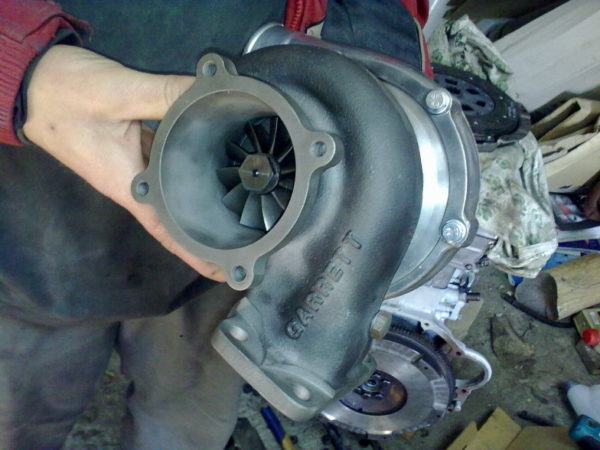
The axis of the turbocharger is fixed on special sliding bearings; Lubrication is carried out by supplying oil from the motor lubrication system. Sealing rings and gaskets prevent oil leakage, as well as air breakthroughs and exhaust gases, as well as mixed them. Of course, it is not possible to completely exclude the fallout in a compressed atmospheric air, but there is no big necessity in this ...
The power of any engine and the performance of its work depends on a number of reasons. Namely: from the working volume of cylinders, on the amount of air-fuel mixture supplied, from the efficiency of its combustion, as well as from the energy part of the fuel. The engine power increases in proportion to the increase in the number of incinerated in it for a certain unit of fuel time. But to accelerate the combustion of fuel, an increase in the reserve of compressed air in the working cavities of the motor is necessary.
That is, the more the unit of time burns fuel, the more air will need to be "shoved" into the engine (not very beautiful word "shove" here, however, it is very good, because the motor itself will not cope with the abandonment of excessive air , and zero resistance filters in this will not help him).
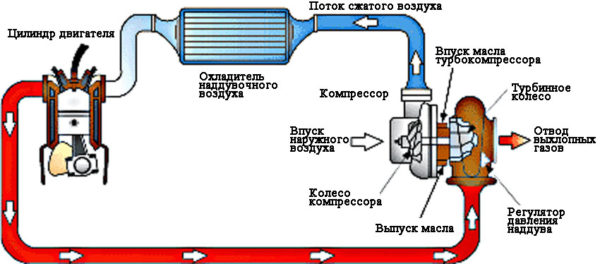
In this, repeat, and consists of the main purpose of turbocharging - in increasing the supply of air-fuel mixture in the combustion chamber. This is ensured by injection of compressed air into cylinders, which occurs under constant pressure. It occurs due to the transformation of the energy of exhaust gases, simply speaking, from the cast and lost - to useful. For this, before the exhaust gases should be removed into the exhaust pipe, and then, and, accordingly, into the atmosphere, their stream is sent through the turbocharger system.
This process ensures the spinning of the turbine wheel ("impeller"), equipped with special blades, up to 100-150 thousand revolutions per minute. On one shaft with the impeller, the blades of the compressor are fixed, which injected compressed air into the engine cylinders. The force obtained from the energy conversion of exhaust gases is used to significantly increase air pressure. Due to the possibility of injection in working cavities of cylinders a much larger amount of fuel for a fixed time. This gives a significant increase in both the power and the efficiency of the diesel.
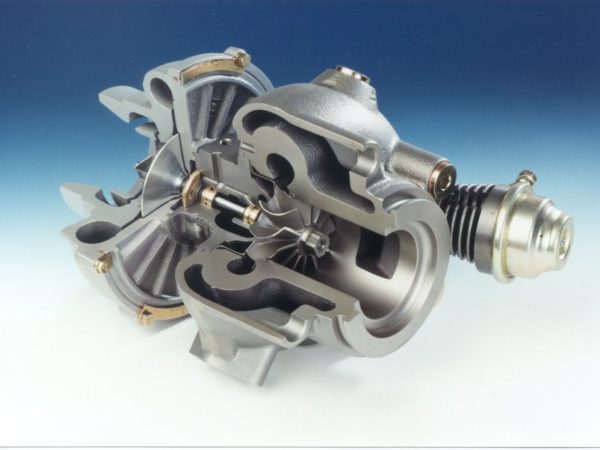
Diesel turbine in cut
Simply put, the turbosystem contains two blade "impellers" fixed on one common shaft. But at the same time in the individual cameras, hermetically separated from each other. One of the impellers is forced to rotate from the engine exhaust gases constantly entering its blades. Since the second impeller with it is toughly connected, it also begins to rotate, capturing atmospheric air and feeding it in a compressed form to the engine cylinders.
More than a dozen years it took engineers to create a truly effectively working turbocharger. After all, it is only in the theory, everything looks smoothly: from converting exhaust gas energy, you can "return" a lost percentage of efficiency and significantly increase engine power (for example, from a hundred to one hundred sixty horsepower). But in practice, for some reason, it did not work.
In addition, with a sharp press on the accelerator, it was necessary to wait for an increase in engine revolutions. It took place only through some pause. The increase in the pressure of exhaust gases, the promotion of the turbine and the contagon of compressed air occurred not immediately, but gradually. This phenomenon, called "Turbolag" ("Turbians") could not be tamed. And it turned out to cope with it, applying two additional valves: one - to cross the excessive air into the compressor through the pipeline from the motor collector. And another valve - for exhaust gases. And in general, modern turbines with a variable geometry of the blades even differ significantly from the classic turbines of the second half of the twentieth century.
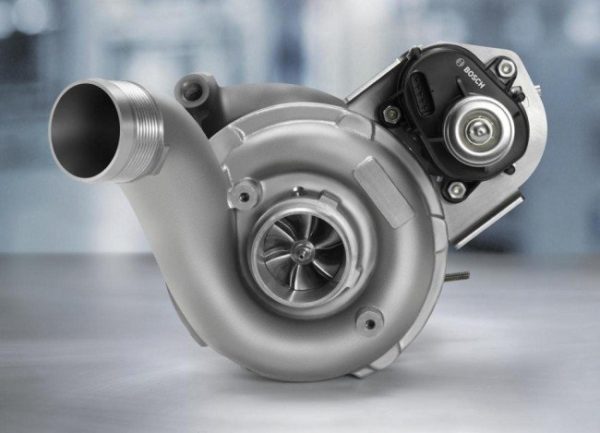
Diesel turbocharger "Bosch"
Another problem that had to solve with the development of technologies of diesel turbines, consisted of excess detonation. This detonation occurred due to a sharp increase in the temperature in the working cavities of the cylinders in the injection of the additional mass of compressed air, especially at the final stage of the tact. Deciding this problem in the system is called by an intermediate charge air cooler (intercooler).
The intercooler is nothing more than a radiator for cooling upward air. In addition to the decline in detonation, it reduces the air temperature also in order to not reduce its density. And it is inevitable during the heating process from compression, and this is largely the effectiveness of the entire system.
In addition, the modern engine turbocharging system does not work without:
- adjusting valve (Wastegate). It serves to maintain optimal pressure in the system, and for its discharge, if necessary, in the receiving pipe;
- bypass-valve (BYPASS-VALVE). His destination is an appropriate air removal back into the intake nozzles to the turbine, if you need to reduce the power and the throttle is closed;
- and / or "Blow-off-valve). Which blends the adequate air into the atmosphere if the choke is closed and the air flow sensor is missing;
- exhaust manifold compatible with turbocharger;
- sealed pipes: air for air supply in the inlet, and oily - for cooling and lubricating the turbocharger.
On the courtyard of the twenty-first century, and no one chases the name of his car with fashionable in the eyelids the XX-M prefix "Turbo". No one believes more than the "magic force of the turbine" for a sharp acceleration of the car. The meaning of the use and efficiency of the turbocharging system is still not in this.
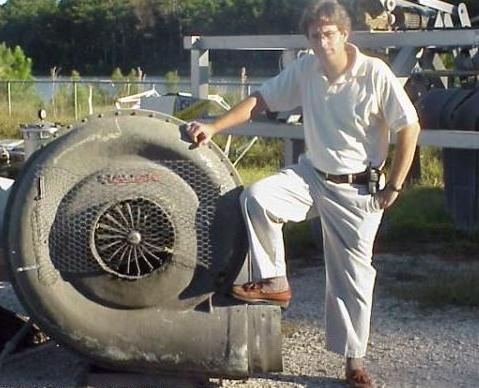
This is "snail"!
Of course, the most effective turbocharging when used on tractors and heavy truck engines. It allows you to add power and torque without the occurrence of fuel recalculation, which is very important for the economic indicators of the equipment. It is used there. They also found their widespread use of the turbosystem also on diesel and ship diesel engines. And these are the most powerful turbine-created turbine for a diesel engine.














